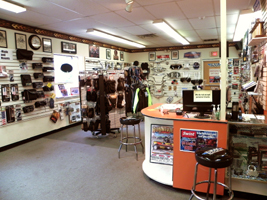Locate Affordable Costs on Motocross Parts NZ for each Bike
Locate Affordable Costs on Motocross Parts NZ for each Bike
Blog Article
Recognizing the Important Parts of a Bike: A Comprehensive Overview for Lovers
For motorcycle fanatics seeking to raise their riding experience and guarantee their bikes run efficiently, recognizing the necessary elements of a bike is vital. Each aspect, from the engine's detailed workings to the vital duty of the stopping devices, not just impacts performance however additionally safety and security and convenience. This guide will walk through the essential components that every cyclist need to recognize with, making it possible for notified selections in both maintenance and possible upgrades. As we start this exploration, one must ask: just how does each part connect to create the smooth experience every lover seeks?
Engine Elements

The camshaft plays a critical duty in regulating the timing of the engine's valves, making certain the precise opening and closing essential for reliable gas and air intake, as well as exhaust expulsion. This timing is crucial to preserving ideal engine performance and efficiency. Furthermore, the carburetor or gas shot system, relying on the bike version, is accountable for mixing air with fuel in the correct proportion for burning.
The cooling system, either air or liquid-based, works to keep the engine's temperature level within operational limitations, preventing getting too hot and guaranteeing longevity - moto parts nz. Each component, thoroughly made and incorporated, adds to the seamless operation of the engine, specifying the bike's power result and overall performance
Transmission System
Integral to the motorcycle's performance, the transmission system makes certain reliable power transfer from the engine to the wheels. This system consists of several crucial components, including the clutch, transmission, and last drive, each playing a crucial role in converting the engine's power right into motion. The clutch, normally operated by a hand bar, offers to disengage the engine and engage from the transmission, allowing for smooth gear changes and regulated velocity.
The transmission, typically referred to as the transmission correct, contains a collection of equipments that riders can by hand move through to readjust the bike's rate and torque output. These gears are prepared in a series that enables the motorcycle to increase efficiently and keep optimal engine performance across different rates. Many motorcycles make use of a sequential gearbox, needing the rider to change equipments in an established order.
Braking Mechanisms
While understanding the transmission system is vital to harnessing a bike's power, similarly essential is the capability to manage and stop that power efficiently, which is where braking devices enter play. Brakes are vital for security and performance, offering the cyclist with the needed control to navigate numerous surfaces and problems. Usually, motorcycles include two kinds of braking systems: disc brakes and drum brakes.
Disc brakes are more widespread in contemporary bikes because of their remarkable efficiency. They include a brake disc, caliper, and pads. When triggered, the caliper presses the brake pads versus the spinning disc, transforming kinetic energy right into warmth, thus reducing the wheel. This system provides far better heat dissipation, regular performance, and boosted stopping power, particularly in wet conditions.
Conversely, drum brakes, though much less usual, are still located in some bikes. They work by pushing brake footwear against the internal surface area of a drum connected to the wheel. While typically much less effective in warm dissipation and quiting power, drum brakes are simpler and much more cost-effective.
Understanding these braking systems' subtleties permits motorcyclists to maintain their motorcycles correctly and appreciate the design that makes sure news risk-free and reliable stopping.
Suspension and Steering
Suspension and guiding systems are vital elements that substantially affect a bike's handling and experience convenience. The shock absorber, containing forks at the front and shock absorbers at the back, soaks up road abnormalities, improving stability and control. Front forks, upside down or normally telescopic, compress and rebound to minimize influences, while rear shock absorbers preserve tire contact with the roadway, crucial for traction and safety.
Guiding, centered around the handlebars, connects the cyclist to the motorcycle's directional control. The steering head bearings make certain smooth you can try here procedure, enabling precise maneuverability. Correct placement and upkeep of these bearings are important for foreseeable steering reaction and decreasing biker tiredness.
The suspension's adjustability is one more crucial aspect; preload, damping, and rebound setups permit personalization to fit different riding styles and conditions. This flexibility is vital for enhancing performance, whether browsing urban streets or dealing with rugged tracks. Developments like digital shock absorber offer real-time changes, improving experience high quality across varied terrains.

Electrical Solutions
After ensuring a controlled and smooth adventure with effective suspension and guiding systems, attention transforms to the electric systems, a crucial element of modern-day motorcycles. These systems play a vital role not just in starting the engine however additionally in powering various elements that improve the capability and security of the bike.
At the heart of a bike's electrical system is the battery, which stores electrical power essential for starting the engine and powering supporting systems - mx gear nz. The alternator or generator, combined with the rectifier-regulator, ensures the battery stays billed while the motorbike is in operation, converting mechanical power into electrical power and preserving voltage degrees
The ignition system, one more essential component, is in charge of igniting the air-fuel mixture in the engine's cylinders. Modern motorbikes typically make use of a digital ignition system, supplying better efficiency and dependability contrasted to standard systems.
Lights systems, consisting of headlights, tail lights, and indicators, are additionally vital, guaranteeing presence and safety for the rider. Additional digital components such as sensing units, control devices, and presents add to sophisticated functions like gas injection management, anti-lock stopping systems (ABS), and electronic control panels, additionally enhancing the riding experience.
Final Thought
An extensive understanding of a bike's necessary components, consisting of the engine, transmission system, braking devices, suspension, guiding, and electrical systems, is crucial for fanatics aiming to enhance safety, convenience, and performance. Proficiency of these aspects enables notified choices concerning upkeep and upgrades, eventually boosting the riding experience. By integrating this understanding, address riders can guarantee their motorcycles operate at peak effectiveness and integrity, thus maximizing both pleasure and long life of their vehicles.
For motorcycle fanatics looking to elevate their riding experience and ensure their bikes run smoothly, recognizing the necessary components of a motorbike is vital.Indispensable to the bike's performance, the transmission system guarantees effective power transfer from the engine to the wheels.While comprehending the transmission system is vital to taking advantage of a bike's power, equally essential is the capability to regulate and quit that power effectively, which is where braking mechanisms come right into play. Commonly, motorcycles include 2 kinds of stopping systems: disc brakes and drum brakes.
An extensive comprehension of a motorbike's necessary elements, including the engine, transmission system, braking mechanisms, suspension, guiding, and electric systems, is crucial for fanatics intending to maximize convenience, safety and security, and efficiency.
Report this page